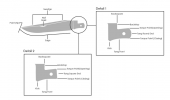- Joined
- Jan 21, 2016
- Messages
- 56
What exactly does the back spring do?
I am a bit clueless about traditional folders. I had a Swiss Army knife as a kid in Scouts but otherwise I've had more modern lockback knives, generally.
I am a bit clueless about traditional folders. I had a Swiss Army knife as a kid in Scouts but otherwise I've had more modern lockback knives, generally.







